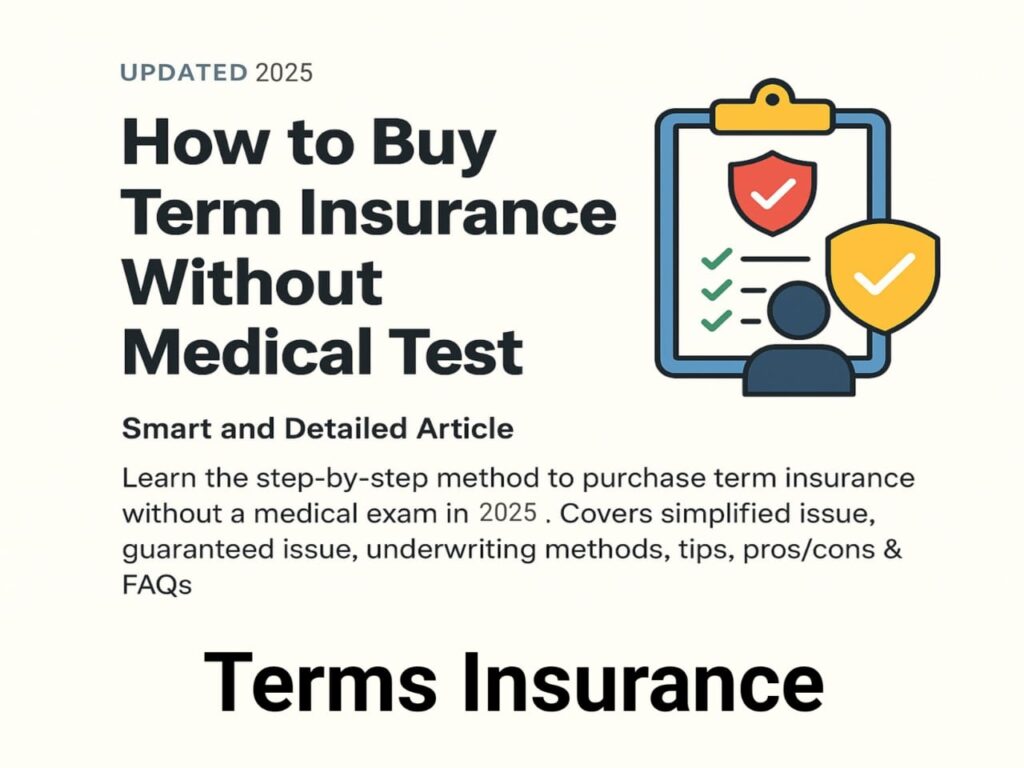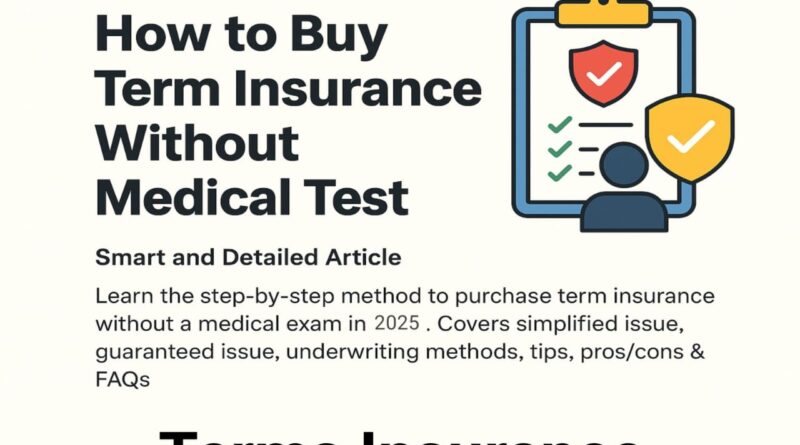How to Buy Term Insurance Without Medical Test – 2025
Introduction (Hook)
Have you ever thought, “I’m young and relatively healthy — why should insurers demand blood tests?” Or maybe you’re anxious about your existing medical conditions disqualifying you from term insurance. The good news is: you don’t always need a medical exam to secure term life protection.
In this guide, I’ll walk you through how to buy term insurance without medical testing — the tricks, the trade-offs, and the secrets insurance companies don’t always highlight. Stick with me, and by the end you’ll know which path fits your life, finances, and peace of mind best.
(By the way — if you ever decide to start a blog about your insurance journey or financial learning, Hostinger is one of the best hosting providers out there. You can build a sleek, fast website with their platform, and I’ve got a link below where you can get 20% off your hosting plan via aftchecker.com. Just saying 😉)

Table of Contents
- What “No Medical Test” Term Insurance Means
- Types of Term Insurance Without Medical Exam
- Simplified Issue
- Guaranteed Issue
- Accelerated / Express Underwriting
- How It Works: Step by Step
- Pros & Cons: When It Makes Sense
- Key Tips to Maximize Approval Odds
- Real-World Examples & Providers
- Internal & External Links Strategy
- Conclusion & Key Takeaways
- FAQ
1. What “No Medical Test” Term Insurance Means
Term insurance typically requires medical underwriting: blood work, urine tests, vitals, etc. But in a no medical test or no medical exam plan, that requirement is either waived or minimized.
- Some plans simply skip lab tests and rely on health questionnaires, prescription history, and records.
- Others are guaranteed issue — no questions about your health at all, but with limited coverage and waiting periods.
- Some use accelerated underwriting techniques that rely on data you’ve already generated (doctor visits, prescriptions, credit, etc.). (Investopedia)
By knowing which class your policy falls in, you can choose wisely.
2. Types of Term Insurance Without Medical Exam
2.1 Simplified Issue Term Insurance
- What it is: Insurance companies ask you a medical questionnaire (yes/no questions) instead of lab tests.
- Typical coverage: Moderate death benefit (e.g. $50,000 to $500,000).
- Who uses it: People who are generally healthy but want a quick application with fewer hurdles.
2.2 Guaranteed Issue Term Insurance
- What it is: No health questions, no tests, everyone in the eligible age bracket can apply.
- Trade-offs: Lower coverage amounts, higher premiums, waiting period (often 2–3 years) before full death benefit is active.
- Use case: Sometimes used by older applicants or people with serious health issues who can’t qualify otherwise.
2.3 Accelerated / Express Underwriting
- What it is: Uses algorithms, external medical databases (e.g., pharmacies, clinics) and predictive modeling to skip or limit medical exams.
- How fast: Decision in 24–72 hours often.
- Limits: For larger coverage amounts, they might still require medical tests.
- Note: This is increasingly common in modern insurance products. (Investopedia)

3. How It Works: Step by Step
Here’s a stepwise approach you can follow:
| Step | Action | What to Expect / Tips |
|---|---|---|
| 1. Assess your health & needs | Check whether your medical history might trigger rejections. | If you have serious conditions, guaranteed issue is likely your path. |
| 2. Choose type (Simplified, Guaranteed, Accelerated) | Based on how much coverage you want and how willing you are to pay. | Balance between convenience and cost. |
| 3. Collect documentation | Your prescription history, doctor visits, records, etc. | Even if no test is required, these data help insurers underwrite. |
| 4. Fill application / questionnaire | Be honest. Don’t omit health issues. | Misrepresentation can void policy later. |
| 5. Insurer does data checks | They may check pharmacy, credit, medical databases. | If red flags appear, they may request tests. |
| 6. Approval or counteroffer | You’ll either get accepted, declined, or accepted with a higher premium. | You can negotiate or try a different insurer. |
| 7. Policy issue and waiting period (if guaranteed) | For guaranteed issue, sometimes there is a 2-3 year waiting period. | In that span, a death benefit may be limited or partial. |
4. Pros & Cons: When It Makes Sense
✅ Advantages
- Quick approval, often the same day or within days.
- No invasive blood draws or lab visits.
- Good option if you have health issues or want immediate coverage.
⚠️ Disadvantages
- Premiums are higher than fully underwritten policies (for same coverage).
- Coverage limits are lower.
- Waiting periods apply (especially for guaranteed issue).
- You might not get the best possible rate.

5. Key Tips to Maximize Approval Odds
- Be truthful & comprehensive — hiding will backfire later.
- Limit your requested coverage — smaller amounts are easier to approve without testing.
- Know your medical records — request your own history if needed, so you know what the insurer will see.
- Apply early — don’t wait until you’re older or your health deteriorates.
- Shop multiple insurers — different insurers have different risk tolerances.
- Avoid applying right after health incidents (e.g. hospital stays) — let things stabilize if possible.
- Use accelerated underwriting when available — if your profile is good, you may skip tests.
6. Real-World Examples & Providers
- Ethos offers no-medical exam term life insurance with fast online approvals. (Ethos Life)
- AAA / ACE offer no-medical exam life insurance / guaranteed issue policies. (AAA)
- New York Life explains how no medical exam options work and what to expect. (New York Life)
- PolicyGenius lists best no exam life insurers. (Policygenius)
- Investopedia notes healthy applicants may get up to $3 million in term life without an exam. (Investopedia)
7. Conclusion & Key Takeaways
Buying term insurance without medical tests is absolutely possible — via simplified issue, guaranteed issue, or accelerated underwriting — but it comes with trade-offs like higher premiums, lower coverage, or waiting periods.
Key Takeaways:
- Simplified issue is often the sweet spot for healthy people who want ease.
- Guaranteed issue is the fallback for those with serious health issues.
- Use accelerated underwriting where insurers allow it to skip tests.
- Be honest, shop multiple insurers, and know your medical record.
- If you publish your findings or a personal finance blog, consider Hostinger for hosting (don’t forget your 20% off link via aftchecker.com).

9. FAQ
Q: Can I get $1 million term insurance without a medical exam?
A: Possibly, if you’re very healthy and going through accelerated underwriting, but many insurers will require tests at higher coverage levels.
Q: Is guaranteed issue term insurance “real” life insurance?
A: Yes, but with restrictions—lower coverage, higher cost, and waiting periods apply.
Q: Will premiums be locked?
A: Yes. Once your policy is issued, your rate is typically locked for the term duration.
Q: Can insurer ask for medical exam later?
A: In most “no exam” policies, not once issued, unless fraud is suspected.
Q: Which is better: full underwriting or no exam?
A: Full underwriting gives you the best rates (for healthy people). No exam gives speed and accessibility.


